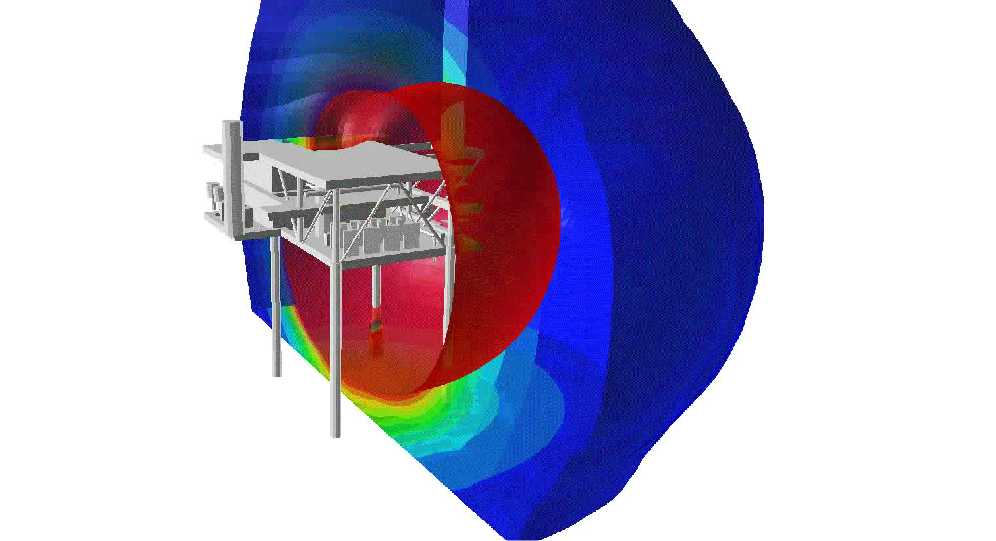Technical safety

Abercus uses the CFD and FEA approaches to simulate and assess a wide range of technical safety considerations, including:
-
atmospheric dispersion of hot/noxious turbine/generator
exhaust plumes and their potential impact on personnel and equipment
-
CAP437 for helideck environment - assessment of turbulence, temperature rise and hydrocarbon accumulation
-
ISO15138 assessment of global and local ventilation efficiency
-
potential for ingestion of noxious gas into HVAC systems
-
dispersion of flammable gas from cargo venting operations and the effect gas detectors
-
NORSOK Z013 probabilistic explosion assessment to determine design accidental loads for structural design and optimisation of structural response
-
deterministic and/or probabilistic fire assessment to determine fire loads for structural design and optimisation of passive fire protection (PFP)
-
flaring operations and impact of radiation upon personnel and equipment
-
probabilistic dispersion assessment for optimisation of gas detector layout
-
subsea bubble plume modelling following subsea loss of containment.
NORSOK Z013 probabilistic explosion assessment
Whilst it is possible to use CFD to simulate gas dispersion and subsequent ignition/explosion, considering just a few worst case, large release (and consequently large flammable accumulation)
scenarios when quantifying design accidental loads for structural design will typically lead to explosion loads that are well in excess of what can be realistically designed for. Instead, the probabilistic approach is often adopted
whereby a larger dataset of cases is simulated, covering a wide range of prevailing conditions, releases and ignition events, each with an assigned probability of occurrence, and used to construct explosion load exceedance
curves which describe the probability of occurrence of explosion loads for structures of interest around a facility.
This approach is set out in NORSOK Z013 and has been used in industry for well over a decade.
Abercus has developed the EXCGEN software for undertaking probabilistic assessments. EXCGEN automates the large number of individual CFD simulations
required for the underlying dataset of cases, to ensure that they're set-up in a rigorous and consistent manner, and the construction of the exceedence curves for all targets of interest.
EXCGEN also provides contour plots of explosion loads corresponding to a prescribed frequency of occurrence across any array of targets specified identified within the underlying CFD models - see, for example, the plot of
10-4/yr overpressure across the blast wall in the image below. This is important because the design loads retrieved from traditional exceedence curves correspond to the peak load anywhere on the structure but this is often extremely localised -
as in the example below where the maximum 10-4/yr peak overpressure (identified by the red contours) occurs over a small area of the blast wall.

Abercus has recently exploited this capability, which is not yet widely available (as of 2014), to determine design exlosion loads for two large offshore projects.
Subsea bubble-plumes following loss of containment
In the event of a rupture of a subsea gas pipeline, the resulting bubble plume may present a risk to operations at the surface
in terms of accumulation of flammable gas and/or loss of buoyancy. The classical engineering calculations for plume behaviour, however, are fairly limited and cannot capture much of the physics that is important for subsea plume behaviour.
Abercus has instead used the CFD approach for operational scenarios on several UKCS fields.
The animations below, for example, demonstrate that the risk at the surface is significantly influenced by the duration of the release,
which is dependent upon the length of unisolated pipeline around the rupture location. The depth of water and the prevailing current are also important considerations.


CAP 437 assessment of helideck environment
Standards for the operating environment above offshore helicopter landing areas are set out in CAP437 by the UK CAA. The document sets out maximum acceptable thresholds for:
-
the vertical component of turbulence
-
the temperature rise above ambient
-
the concentration of flammable hydrocarbon accumulation.
Abercus uses the CFD approach to assess the offshore helideck environment for each of the three CAP437 criteria,
to allow operators and asset owners to demonstrate that the working environment for the helideck at their asset is safe,
or to identify whether any operational restrictions may be required.

